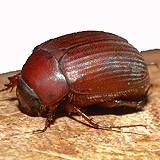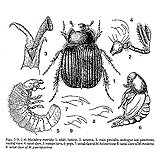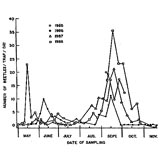Maladera (Cephaloserica) insanabilis Brenske, 1894: 37
This species appearing as new pest, was described in Israel in 1986 by Argaman as Maladera matrida and only few years later recognized as synonymous of M.insanabilis Brenske an oriental invasive species that
in few years colonized the the Middle East (Iran, Oman, Saudi Arabia, Israel, Jordan) and North Africa (Lybia).
In Israel the species first appeared in 1983 in residential areas around Tel Aviv, in the coastal plain. It appeared in large number and became a nuisance as it is attracted to light and enter lighted porches and houses
feeding on ornamentals and annoying people (in Israel it is still polularly called "Komeini beetle"), it spread rapidly and in 1885 it was recorded in the central part of the coastal plain (between Hadera
and Ashdod) and in the Negev.
The insect is found in irrigated fields, orchards and ornamental home gardens and parks, and in the root system of weeds.
Heavy injoury, caused by audults feeding on foliage, was recorded in citrus, avocado, macadamia and cherry trees. The grubs cause serious losses by feeding on living roots of sweet potato, peanuts and strawberry plants. Because of the economical importance of this Sericidae, its behaviour and phenology has been object of several studies.
Gol'berg et al. indicate that this species has 2 generations annually, adults emerge in March,
April, or May and disappear in October or November; the specimens mate and feed at twilight and in the dark. The graph below shows the phenology of M.insanabilis in Israel (Bed Dagan) as recorded by balack-light traps in 1985-1988.
 |
 morphology, from Argaman, 1990 |
 phenology, from Gol'berg et al., 1989 |
 |
 |